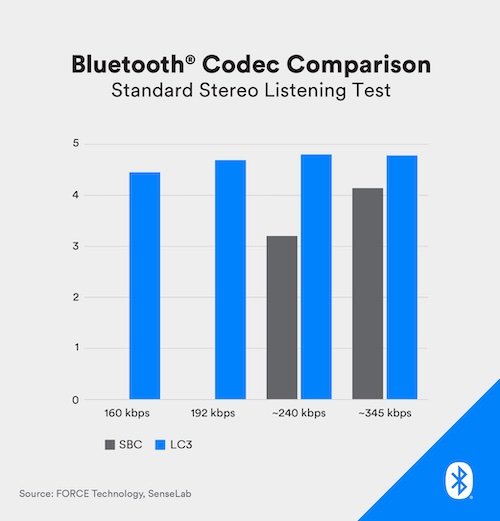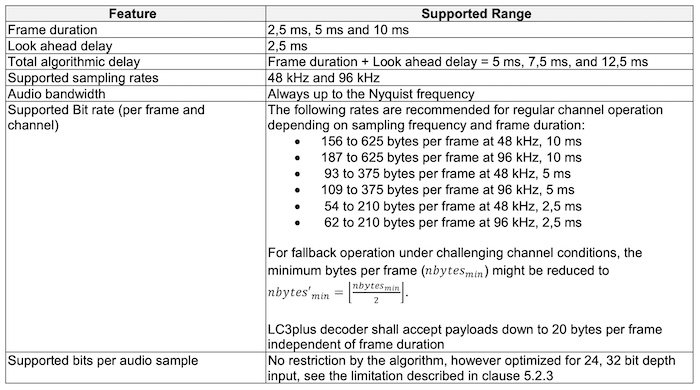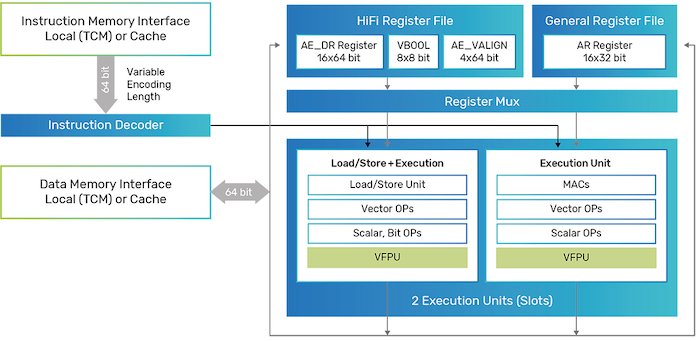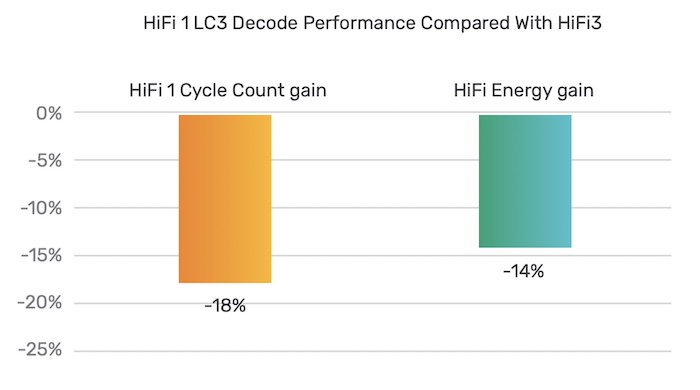Codec development is a constantly evolving process. Audio and video codecs are used to minimize the size of a stream of data prior to transmission and restore that data on the receiver side with a minimum of loss or no loss.
Until 2020, the Bluetooth Group used a codec called subband codec (SBC) as its main workhorse. Its new codec, low complexity communications codec (LC3), is said to provide a higher quality audio experience while maintaining lower bit rates when compared to the previous generation SBC.
Of course, to take advantage of a codec, a designer has to implement that architecture into their SoC (system on chip) designs.
Cadence Design Systems recently announced the HiFi 1 DSP (digital signal processor) chip, which claims to extend the battery life and improve user experience in several classes of devices, including hearables, wearables, and always-on-devices.

Artist representation of the Cadence HiFi 1 DSP. Screenshot used courtesy of Cadence
Today, let's look at the basic coding features of LC3 & LC3plus, as well as the architecture of the HiFi 1 DSP from Cadence.
What Are LC3 and LC3plus?
LC3 is an audio codec created by Fraunhofer IIS and Ericsson, which was then adopted by the Bluetooth Group in 2020 under the name LE Audio.

Relative listening test measurements between SBC and LC3. Image used courtesy of FORCE Technology, SenseLab, and Bluetooth SIG
If interested, you can find the comprehensive details of the codec implementation for LC3 in the Bluetooth LC3 specification PDF here. An excerpt below shows the features of coding one audio channel.

Coding features for the LC3 codec. Screenshot used courtesy of Bluetooth SIG [PDF]
LC3plus is a superset codec of LC3, standardized under ETSI as ETSI TS 103634, which offers advanced audio features including high-resolution audio, forward error correction, low-delay modes (down to 2.5 ms packet sizes), and packet loss concealment.
The main LC3plus basic features are largely similar to LC3. The superset codec also supports the following high-resolution audio mode features.

Coding features for LC3plus high-resolution audio. Screenshot used courtesy of ETSI
Together, these codecs represent the next-generation transmission protocol for enhanced voice services and audio for Bluetooth, Voice over Internet Protocol (VoIP), and digital enhanced cordless telecommunications (DECT). The reduced bitrate and efficient frame durations optimize the time spent encoding/decoding and transmitting audio resulting in a reduced power requirement.
Manfred Lutzky, Head of Audio for Communications at Fraunhofer IIS, believes that developers could leverage the power savings of LC3plus to create products that can provide longer battery life or reduce the form factor by using a smaller battery.
Now that LC3 and LC3plus are a bit clearer, let's look at some applications for LE Audio.
LE Audio Bluetooth Applications
Imagine a movie theatre where the movie's audio is broadcast directly into customer headsets allowing for a truly personal and undisturbed experience. Using the LC3 codec, LE Audio could open the door to numerous applications waiting for Multi-stream or Broadcast audio capability.
Audio broadcasting seems like a simple feature by today's standards; however, let's consider the communication channel for a single set of wireless earbuds. In the past, designers were forced to transmit from the source audio to a single device and hop between devices to provide a left and right audio channel.
Multi-stream capability reduces design complexity by transmitting synchronized audio to two related earbud devices for 'truly wireless earbuds.' Beyond a single user, LE Audio Sharing feature Broadcast allows an audio source to connect to unlimited audio sink devices.
With these potential applications, the benefits of LC3 are apparent. Also hoping to capitalize on LC3 is Cadence's HiFi 1 DSP.
Cadence Design Systems HiFi 1 DSP Optimizes BLE Codecs
The Cadence Tensilica HiFi 1 DSP IP core is said to be the smallest HiFi DSP.
Capable of encoding/decoding LC3, the HiFi 1 IP core addresses issues related to wireless audio reliability, AI in audio, voice control, and improvements in battery life.
The HiFi 1 architecture is based upon the Harvard architecture, where it fetches both data and instructions in parallel. The bus architecture is 64-bits wide and allows for several multiply/accumulate (MAC) configurations. The architecture is said to help with neural network workloads by handling packed 8-bit data.

HiFi 1 DSP is a 64-bit Harvard-based IP core for LC3 and AI applications. Image used courtesy of Cadence
Compared to HiFi 3, Cadence's leading audio DSP, HiFi is said to be more cycle and energy-efficient, which is in addition to an 11% to 16% lower design area and a 60% to 73% improvement in cycle & energy efficiency for machine learning (ML) keywords.

Performance gains over HiFi 3 DSP for the LC3 codec. Screenshot used courtesy of Cadence
The LC3 codec will enable better experiences for users, improve and simplify designer's applications, and enable more energy-efficient audio systems. Cadence's newest DSP offers designers a faster time to market with a ready-tested IP core, allowing designers to focus on end-user products rather than architecture design.
